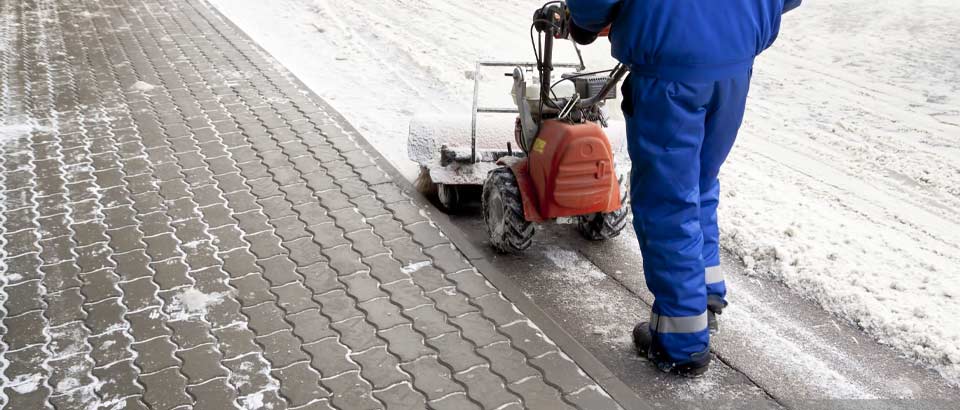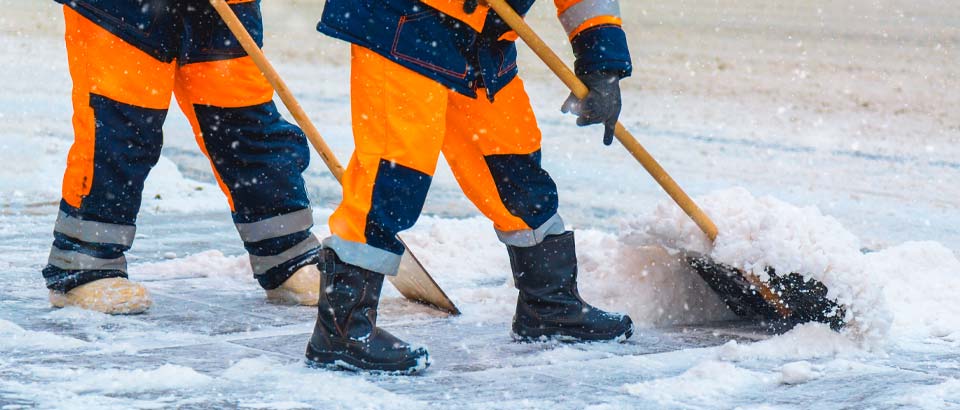August 12, 2024
In the colder months of the year, snow removal is an important part of doing business. Whether it’s a light dusting or more than a foot from a heavy storm, it must be removed so that your business can open safely, and customers can enter without risk of falling. But, as an employer, it’s important to be aware of the potential health hazards that come with snow removal. We’ve got you covered with some helpful information and tips to make sure it’s done properly so the risk of injury is low.
The Cold Facts About Snow Shoveling
What’s the big deal about snow? Well, every year, over 137,000 people see medical providers for snow-shoveling-related injuries.1 Of those people, around 28,000 end up in emergency rooms.2 This kind of work also increases the likelihood of musculoskeletal injuries like sprains and strains to the back, arms and shoulders and legs.1 Lacerations are common, and even breaks and fractures can occur. A slip on wet snow or ice may also cause a concussion.4
The more snow there is, the more risks there are. The risk of injury rises with both amount of snow and duration of snowfall. For example, more than eight inches of snow resulted in a 16 percent increase in hospital admission for serious cardiac concerns and a 34 percent increase in deaths from heart attacks. Long periods of snowfall showed similar risk.3
As an employer, you should always keep the health and well-being of your workforce top of mind. When low temperatures and winter weather occur, it’s important to know how to keep them warm and safe. Clearing snow from sidewalks, driveways, parking lots and more can be dangerous. Read on to learn how remove snow safely and protect workers against injury.

Create Your Cold Weather Plan
Planning for cold weather work before the snow even begins to fall is a good place to start. By having a plan in place, you are not just preparing for the upcoming season. You’re showing your employees that their health and safety is a primary concern.
OSHA advises employers to prepare for winter weather by creating a cold weather plan.5 Here are some suggestions on what to include:
- Train workers about cold stress and recognizing cold weather hazards such as slippery roads and surfaces, downed power lines and windy conditions.
- Provide engineering controls such as radiant heaters, areas protected from wind chill and drafts, and appropriate tools such as weatherproof ladders and aerial lifts to prevent falls.
- Implement safe cold weather work practices, including:
- Provide proper and necessary tools and equipment for the job
- Have a safety measures plan
- Schedule outdoor jobs during the warmest part of the day
- Avoid exposure to extremely cold temperatures or limit time spend outside
- Schedule frequent breaks in a warm, safe room or area
- Provide warm beverages
- Monitor storm conditions by using a reliable weather source like National Oceanic and Atmospheric Administration (NOAA)
- Have a reliable means of communication that will work in a storm
- Have evacuations plans ready, if needed
Dress for the Job
Snow removal is hard work. Your team should be dressed properly so they can keep warm and protect themselves from chills brought on by sweating. In some severe cold weather conditions, the CDC recommends the use of personal protective equipment (PPE).6 Examples of cold weather PPE include insulated overalls, jackets, work boots and goggles.
While not all cold weather requires PPE, layering is key – three layers, to be exact: inner, middle and outer.4
- Inner: Helps wick sweat away from the body. Silk, wool and synthetics like polypropylene are ideal for inner layers. Avoid cotton.
- Middle: Provides insulation even when wet. Wool or synthetic fabrics are best.
- Outer: Wind and rain/snow protection with ventilation for air flow. Insulated, water-resistant coats are ideal for the outer layer.
Other necessary clothing items include water-resistant, insulated gloves; a hat that covers the ears; a knit mask that covers the face; and insulated, waterproof boots or shoes. It’s also wise to have a second set of clothing in case the first gets too wet. Remember to avoid clothing that it too tight, since it can restrict blood flow.
Creating a Safe Environment for Snow Removal
Shoveling and removing snow can be good exercise, but it can also cause a host of problems, including potentially serious injuries like sprains and strains in your back and shoulders.7 Doing things the right way is important to help to prevent such injuries.
Here are two important things to do before starting to clear snow:8
- Check the worksite for any potential hazards is where all snow removing jobs should begin. Hazards include downed power lines, branches that might collapse from the weight of the snow, ice-coated areas where the risk of slipping and falling is higher, and carbon monoxide poisoning from improper ventilation when using generators.
- Make sure that all workers are properly trained in the use of any snow removal equipment.
The CDC recommends the following steps just prior to starting snow removal: 9,10
- Remove all potential hazards from areas where ladders will be used, such as ice and debris.
- Do not touch or attempt to move downed power lines. Call the proper local authorities and wait for their instructions.
- Have workers stretch prior to shoveling to prepare their muscles for the job.
Remind workers of the correct shoveling process. Always remember the old adage: lift with your legs, not with your back. Bend at the knees rather than the waist. Hold the shovel so that the blade is close to the body instead of an arms-length away. Unbend the knees and push up with the legs to reduce back strain. Don’t throw the snow. Instead, push it aside. Keep the loads of snow on the smaller side so it’s easier to move them.
The design of the snow shovel being used is another important consideration, whether using a traditional one or a push-style.11 Shovels should be light and comfortable to use, and of a length appropriate to the height of the worker.9 The shaft of the shovel should be bent-shaft or ergonomic for both comfort and reducing injury risk.12,13
 What to Watch For
What to Watch For
Slips, falls, sprains and strains aren’t the only issues that can happen while shoveling snow. Cold weather can lead to serious health problems as well.
Cold weather dehydration is a very real problem,14 so make sure your workers are taking frequent breaks and hydrating as they work. Watch for signs of dehydration15 as well, such as:
- Bloody nose
- Chapped lips
- Very dry skin
- Dry mouth
- Increased thirst
- Dark yellow urine
Severe dehydration symptoms include confusion, dizziness, heart palpitations, and fainting. If anyone experiences these symptoms, medical help is needed right away.
Heart attacks are a serious and sometimes fatal issue for people handling snow removal. Employees with known cardiac conditions should talk to their provider about safe levels of physical work and as an employer, you should be aware if your employee is at risk before shoveling snow. If something were to happen while shoveling to your employee, it’s also important to know the signs of heart attack:16
- Chest pain or chest discomfort (including a squeezing or full feeling, or pressure in the chest) – the pain and discomfort can go away and come back or last for minutes at a time.
- Weakness, faintness or light-headedness – breaking out in a cold sweat is also common.
- Pain or discomfort in the back, neck, jaw, arms or shoulders
- Shortness of breath or difficulty breathing
Supervisors and employers should also make sure they are aware of any workers who may be at-risk due to an existing heart condition or similar. Anyone experiencing heart attack symptoms should stop work immediately and call 911 or head straight to the nearest emergency room.
Our Team Can Help You
If one of your employees is injured or develops a health issue while clearing snow, they can visit one of our centers to get the help they need. We can assist with injuries, illnesses and more. Learn how we can help and to find your closest neighborhood medical center.
Originally published December 2022. Updated August 2024.
References:
1 American Academy of Orthopedic Surgeons. Prevent Snow Shoveling and Snowblowing Injuries. Accessed October 18, 2022.
2 Consumer Reports. Snow Shoveling Safety Tips You Need Now. Accessed October 18, 2022.
3 OrthoBethesda. Common Snow Shoveling Injuries. Accessed October 24, 2022.
4 Des Moines University Medicine & Health Sciences. Snow Shoveling: Ergonomics to Help Prevent Snow Injuries. Accessed October 24, 2022.
5 United States Department of Labor. Occupational Health and Safety Administration (OSHA). Winter Weather. Accessed October 18, 2022.
6 Centers for Disease Control and Prevention (CDC). The Physiological Response of Working in Cold Environments and how your PPE can help. Accessed October 18, 2022,
7 International Conference on Industrial Engineering and Operations Management. Ergonomic Assessment of Snow Shovels Using Digital Human Modeling. Accessed October 24, 2022.
8 OSHA. Snow Removal: Know the Hazards. Accessed October 24, 2022.
9 CDC. Digging Out: Five Ways to Prepare Your Health to Shovel Snow. Accessed October 24, 2022.
10 Safety & Health. Safe snow removal. Accessed October 24, 2022.
11 Architectural Foundation. Top 15 Best Snow Shovels on the Market 2022. August 2022.
12 Applied Ergonomics. Influence of snow shovel shaft configuration on lumbosacral biomechanics during a load-lifting task. Accessed October 24, 2022.
13 XXIInd Congress of the International Society of Biomechanics. EMG Comparison of Two Types of Snow Shovels. Accessed October 24, 2022.
14 Denver Health. Winter Dehydration: Is It Real? Accessed November 8, 2022.
15 Kaiser Permanente. 10 Warning Signs of Dehydration. May 2022.
16 CDC. About Heart Attack Symptoms, Risk, and Recovery. Last updated May 15, 2024. Accessed August 12, 2024.
17 Harvard Medical School. Can shoveling snow put your heart at risk? Accessed October 18, 2022.
